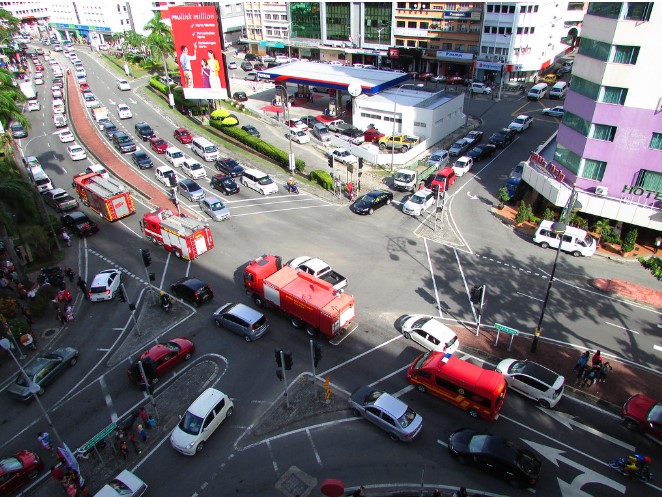분류 [Engineering/Technology] Researchers from Incheon National University Advanced Adaptive Traffic Monitoring with Smart Cameras
- NO
- 399854
- Date
- 2025-01-08
- Modify Date
- 2025-01-08
- Writer
- 연구기획관리과 (032-835-9322~5)
- Count
- 118
Researchers from Incheon National University Advanced Adaptive Traffic Monitoring with Smart Cameras
A new camera-based system adapts to traffic flow, improving road safety and reducing energy use
Researchers at Incheon National University have developed a smart traffic monitoring system using adaptive cameras. The system dynamically activates more cameras during busy times and fewer during quiet periods, optimizing resource use and improving road safety. Tested in diverse scenarios, it shows the potential to reduce accidents, ease congestion, and conserve energy, making it a promising solution for smarter urban traffic management.

Image title: An adaptive camera network dynamically adjusts to urban traffic, ensuring safety, efficiency, and energy savings—pioneering the future of intelligent transportation in smart cities.
Image caption: Exploring the Impact of Preoperative Acupuncture and ESI on Post-Surgery Infection Risk in Lumbar Fusion Patients
Image credit: "Fire Engines Rushing To Fire In Downtown Kota Kinabalu" by thienzieyung
Link: https://openverse.org/image/0acdf923-928a-47f8-b274-c04287ced9d6?q=camera+for+traffic&p=32
License type: CC BY 2.0
Usage restrictions: Cannot be reused without permission
Effective urban traffic management remains a cornerstone of smart city development. With the rise of autonomous vehicles and connected transportation systems, dynamic surveillance solutions are critical to ensuring smooth traffic flow, minimizing accidents, and optimizing efficiency. However, traditional static camera setups often fail to adapt to rapid changes in traffic conditions, resulting in inefficient monitoring and resource use.
To address this issue, researchers from Incheon National University, led by Associate Professor Hyunbum Kim, have introduced a groundbreaking solution: an augmented fluid surveillance system-designed to adapt in real-time to varying traffic scenarios. This paper was made available online on June 25, 2024 and published in Volume 11, Issue 22 of IEEE INTERNET OF THINGS JOURNAL (pg2,3) on November 15, 2024.
The innovative system employs a network of single-lens cameras arranged in a dynamic grid. This model intelligently adjusts its surveillance coverage by activating or deactivating cameras based on real-time traffic conditions, ensuring efficient and flexible monitoring. Dr. Kim, the lead researcher, explains, "Our motivation stems from the growing need for adaptive traffic monitoring systems that can handle diverse and unpredictable scenarios. By creating an augmented fluid surveillance system, we aim to revolutionize traffic management and provide seamless intelligent transportation services."
To achieve this, the study formalized the “Augmented Fluid Surveillance Efficiency Maximization Problem” (MaxAugmentFluSurv). This problem focuses on finding the best way to place and use cameras for maximum efficiency while still covering all necessary areas. The researchers came up with two smart solutions to address this challenge. The first approach, called the Random-Value-Camera-Level Algorithm, organizes cameras in a 3x3 grid. Some cameras are always on to ensure basic coverage, while others switch on or off depending on traffic levels. This way, during busy times, more cameras turn on to monitor the situation, and during quiet times, fewer cameras are active, saving energy.
The second approach, called the ALL-Random-With-Weight Algorithm, works similarly but is even more flexible. It assigns a unique role to each camera based on its position in the grid. Cameras in key positions stay active all the time, while others adjust their activity to match traffic conditions. This method ensures a balance between thorough monitoring and efficient energy use.
Extensive simulations showed these methods worked effectively under different conditions, such as varying traffic levels, slopes, and angles. The system reduced energy use during low traffic and provided strong coverage during peak hours by predicting and adjusting to traffic patterns. "Our approach optimizes camera usage and saves energy while ensuring reliable surveillance. It’s a step toward smarter and more eco-friendly traffic management," highlights Dr. Kim.
Beyond traffic control, this adaptive system could also be used for crowd monitoring, disaster response, and industrial safety. Future efforts will focus on real-world tests and integrating technologies like deep learning for even better performance. This innovation represents a major step in building smarter and more sustainable cities.
Reference
|
Authors: |
Minsoo Kim1, Jalel Ben-Othman2, and Hyunbum Kim1 |
|
Title of original paper: |
Augmented Fluid Surveillance Using Grid Sensing for Intelligent Transportation Service |
|
Journal: |
IEEE INTERNET OF THINGS |
|
DOI: |
|
|
Affiliations: |
1Department of Embedded Systems Engineering, Incheon National University, Incheon, South Korea. 2Université Paris-Saclay, Gif-sur-Yvette, France
|
About Incheon National University
Incheon National University (INU) is a comprehensive, student-focused university. It was founded in 1979 and given university status in 1988. One of the largest universities in South Korea, it houses nearly 14,000 students and 500 faculty members. In 2010, INU merged with Incheon City College to expand capacity and open more curricula. With its commitment to academic excellence and an unrelenting devotion to innovative research, INU offers its students real-world internship experiences. INU not only focuses on studying and learning but also strives to provide a supportive environment for students to follow their passion, grow, and, as their slogan says, be INspired.
Website: https://www.inu.ac.kr/sites/inuengl/index.do?epTicket=LOG
About Associate Professor Hyunbum Kim
Dr. Hyunbum Kim received his Ph.D. degree in computer science from the University of Texas at Dallas, USA, in 2013. He is currently an Associate Professor in the Department of Embedded Systems Engineering at Incheon National University, South Korea and a lab founder of intelligent computing and next generation system lab (ICONS). His research interests include algorithm design and performance analysis in various areas including next generation frameworks, intelligent transportation systems, sustainable computing, beneficial platforms, virtual emotion system, smart cities, cyber security. He is IEEE Senior Member.
